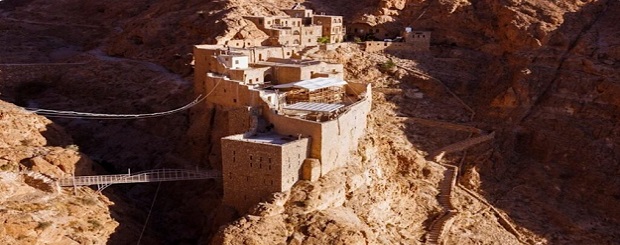
Are the last rites being read for Middle Eastern Christianity?
December 14, 2021 – World – PREVIOUS ARTICLE:
In her book on Christianity’s exodus from the Middle East, the veteran war-reporter Janine di Giovanni roams far and wide to find out why 2,000 years of history may be nearing an end. She tours monasteries in Syria’s warzones, visits embattled enclaves in Egypt, and meets Iraqi Christians from Mosul, who had “N” for “Nazarene” daubed on their doors by Islamic State.
Yet among the more poignant symbols she notes are not the bombed-out churches on the frontlines, but the crucifix tattoos on the young waiters who serve her lunch in the tranquil northern Iraqi city of Irbil. The tattoos are not hipster affectations, but symbols of a creed whose adherents no longer know their place – “the garish ink depicting a permanence belied by their current predicament”.
“I talked to them about their insecurity,” di Giovanni writes. “How they had been separated from family during the Isis invasion, how they feared the future, how they were saving their wages so they would be able to pay illegal smugglers to get them out of Iraq. But once out, where would they go?”
Quite a few places, actually. Such has been the Middle East’s turbulence over the last half-century that its Christians have been forced out: diasporas range from Chicago to Ealing in west London. The exodus is particularly marked in Iraq and Syria, where the Christian minority had traditionally enjoyed the protection of secular strongmen such as Saddam Hussein and Bashar al-Assad. In Iraq, where an estimated 1.4 million Christians once lived, there may now only be 250,000. In Syria, around 700,000 Christians of the pre-civil-war population of 1.1 million have left.
Di Giovanni, who has been covering the Middle East for 30 years for high-end publications such as Vanity Fair, is well placed to chronicle the exodus – and savvy enough not to blame it all on some sinister grand scheme by the region’s Muslims. In recent years, after all, some in the West have portrayed this as close to a genocide, underplayed by a liberal media that now finds Christianity a bit embarrassing. But while Christians have suffered at the hands of Sunni fanatics like Isis, so too have many Muslims, Yazidis and other minorities: the reason they are fleeing is often just the general lawlessness, lousy government and a desire to seek a better life abroad.
Still, di Giovanni makes it clear why many Middle Eastern Christians feel their fortunes to be particularly on the wane. After 1945, they often formed an educated middle class, whose acumen in commerce, medicine and teaching was appreciated by progressive-minded despots. For example, the urbane, cigar-smoking Christian Tariq Aziz, Iraq’s foreign minister, was for years the acceptable face of Saddam Hussein’s regime.
Even after Saddam’s 2003 downfall – which many saw as a US “crusade” – there were no organised reprisals against the invaders’ co-religionists. But while al-Qaeda’s Sunni extremists focused mainly on murdering fellow Muslims, Christians suffered too. Then, in 2010, Islamic State gunmen stormed Our Lady of Salvation Church in Baghdad, killing 58. The group’s subsequent seizure of northern Iraq, including ancient Christian towns such as Qaraqosh, was for many the final straw. As one despairing churchman tells di Giovanni: “Now they are leaving because there is no life for them. How can I tell them to stay?”
Things are scarcely better in Syria, where Christians have had little choice but to rely upon the Mafia-like protection of President Assad, himself a minority Alawite. A Syrian bishop tells di Giovanni that only Assad can hold Syria together – aware, presumably, that by taking sides, his flock may be tainted.
Indeed, the only Christians whose future seems reasonably assured in the Middle East are Egypt’s Copts, who, at up to 10 million, are perhaps simply too numerous to be pushed out. Ironically, it is here that community tensions seem worst. In 2013, mobs attacked 42 churches, and in the Christian districts di Giovanni visits, locals complain of being treated as second-class citizens.
Di Giovanni writes elegantly, her reporting informed partly by being a Christian herself. However, the focus of this book surprised me: nearly half of it is about Christians in Egypt and Gaza, where now barely 1,000 live. I am surprised her editors didn’t ask her to concentrate mainly on Iraq and Syria, where the Christian exodus has been at its most dramatic.
As such, it underplays some key chapters in the “exodus” narrative. The reason Christians first fled post-Saddam Iraq in droves was because their prosperity made them targets for criminal kidnappers, and because they tended to turn the other cheek rather than form militias. There is no mention of how the Baghdad Christian enclave of Doura – once nicknamed “The Vatican” – was over-run by al-Qaeda in 2006, or how the Iraqi capital’s Christian flock is now among those most at risk of becoming extinct, having reached a tipping point where most Christian families have more relatives outside of Iraq than in.
On which note, it would also have been interesting to read about life for the diaspora in the “Little Baghdads” of Chicago and Ealing. The irony is that, by offering Christians sanctuary, the West is inadvertently hastening Middle Eastern Christianity’s demise all the more.
The Vanishing in Telegraph Bookshop
Colin Freeman The Telegraph Source: Yahoo Life
allinnet.info/world/are-the-last-rites-being-read-for-middle-eastern-christianity/
